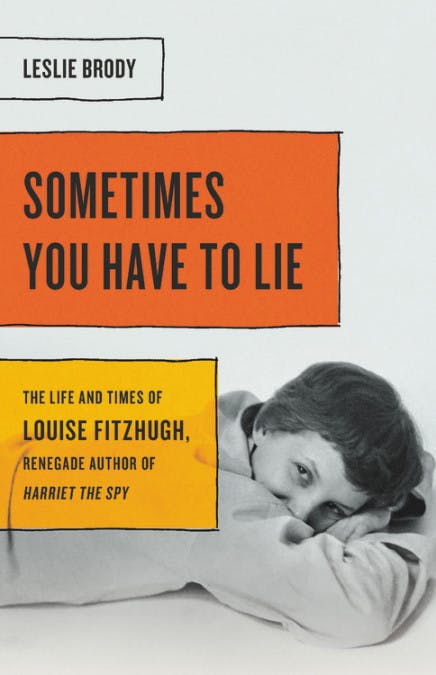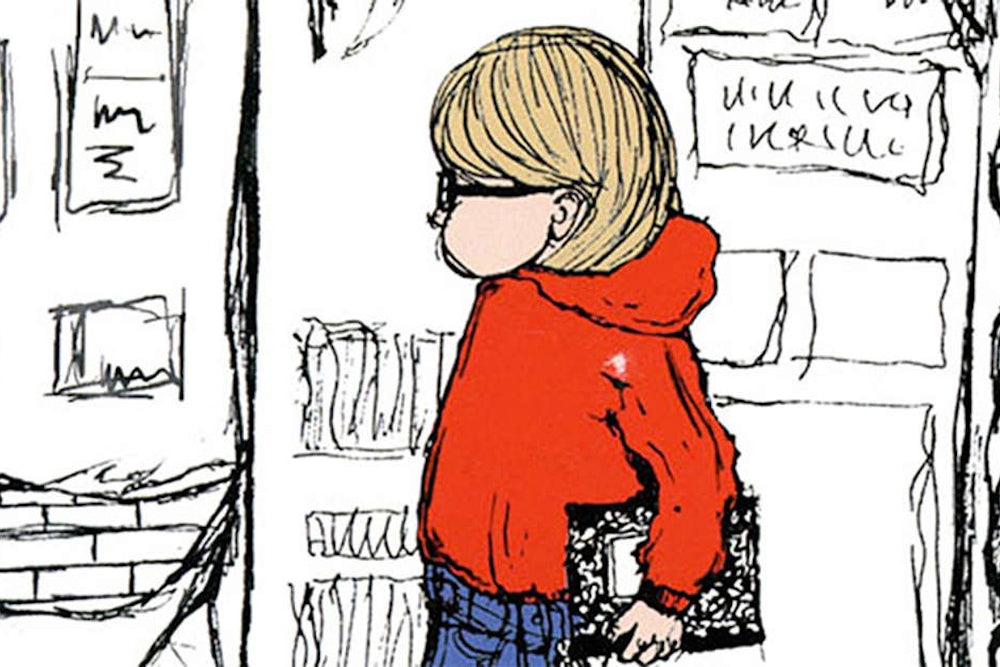Leslie Brody’s Sometimes You Have to Lie is the second biography we have of Louise Fitzhugh, the author of the beloved children’s novel Harriet the Spy. The other appeared in 1995 to little fanfare. Its author was the intriguingly named Virginia L. Wolf, a writer whose only other published book is a reading companion to Little House on the Prairie. The lack of public information on Fitzhugh is a bit confounding, not least because her claim to fame is a novel about collecting as much information on people as possible. Published in 1964, Harriet the Spy followed the adventures of Harriet M. Welsch, a little girl who enjoys a carefree life of snooping on her Manhattan neighbors and eating bland sandwiches until, one day, the jig is up, and the notebook she’s been writing her astute but cruel observations in is discovered by her classmates and friends.

It turns out that Fitzhugh intimately knew the dangers of having your cover blown. As a lesbian writing children’s literature in the aftermath of the McCarthy era, she guarded her privacy by necessity. Despite her book’s extraordinary success, Fitzhugh gave no interviews, did no readings at children’s bookstores, and generally refused to participate in Harper’s publicity campaign. She was motivated in part by a bohemian, countercultural disgust with the book marketing game, but the political climate at the time was certainly another factor. “For Louise, exposure could have caused real trouble,” Brody writes. “Not just for herself, but also for her agent, editor, and publisher, all of whom might be publicly hounded, censored, and boycotted.”
When Fitzhugh tried to follow up Harriet the Spy with a novel that centered on a lesbian relationship, her agent (who herself was bisexual) was said to be “quite terrified” by the material and worried about the public’s reaction, given her client’s reputation as an author of books for children. The manuscript, titled Mimi, never made it to publication.
In Sometimes You Have to Lie, Brody explores these hidden corners of the celebrated author’s life, crafting a personal and political biography of Fitzhugh that situates her popular children’s novel in the context of the homophobia and conformity of the postwar era. The result is a study that reveals the quiet subversiveness of Harriet the Spy and adds sharp political potency to the book’s seemingly innocent play with questions of secrecy and surveillance.
Fitzhugh was born in 1928 into a wealthy society family in Memphis, Tennessee. Her parents had a turbulent marriage. Millsaps Fitzhugh was a lawyer and local politician, and her mother, Mary Louise, was an aspiring dancer who remained aspiring, much to her frustration. The two were profoundly incompatible, and the stress of the marriage led Millsaps to develop hypertension, for which the treatment during Prohibition was whiskey—“three to four glasses every day” precisely. In a highly publicized divorce trial, Millsaps won sole custody of baby Louise, who would be told throughout much of her childhood that her mother was dead; a friend would later inform Louise that living through such tragic and chaotic early events was ideal training ground for a writer. No doubt being the center of town gossip and an object of curiosity for nosy strangers also left its mark.
Young Louise rebelled against the materialism and stuffiness of her father’s life by traveling, with the help of her allowance, to Paris and Greenwich Village, where she fell in with leftist artists and intellectuals. For a time, she lived in Bologna, Italy, ostensibly to study painting but also, Brody writes, because “she believed it to be a communist city, one of the few outside Eastern Europe or China, and she was curious to learn what life there might be like.” In New York City, she was a fixture in the downtown lesbian party scene, mixing with the likes of Djuna Barnes and the Marxist playwright Lorraine Hansberry, with whom she exchanged letters about politics and art.
At the time, Louise was working as a portrait artist and illustrator. She did the drawings for a children’s book called Suzuki Beane (1961), written by her friend Sandra Scoppettone, about a beatnik girl who lives on Bleecker Street. The book was a hit. One review said of Suzuki Beane that it did “for the kindergarten set what Jack Kerouac’s On the Road did for their (slightly) elders.” Buoyed by this triumph, Louise decided to try her hand at writing a children’s book on her own this time. In a letter to a friend, she said she was working on something new: “It is called Harriet the Spy and is about a nasty little girl who keeps a notebook on all her friends.”
When Harriet the Spy came out in the mid-1960s, spies were everywhere—from John le Carré’s The Spy Who Came in From the Cold (1963) and Ian Fleming’s James Bond books to the “Spy vs. Spy” comic strip in Mad Magazine—and the world had learned that the scary prospect of nuclear winter was also the stuff of bestsellers. It was no surprise then that writers of children’s literature would want to get in on the fun of double agents, bad disguises, and elaborate gadgets (though Harriet’s magnifying glass is not exactly the tear-gas cartridge disguised as a tin of talcum powder from To Russia With Love). For much of the book, Harriet’s version of spycraft is decidedly playful; when she does not want to go to dancing school because it’s “not something spies do,” her nanny, Ole Golly, tells her about Mata Hari and how she used her wiles as a dancer to collect intelligence. “Now how are you going to be a spy if you don’t know how to dance?” Ole Golly asks her. As Brody notes, Harriet the Spy treats “stalking, peeping, eavesdropping, and occasional breaking and entering” as actually quite innocent activities. Harriet, Brody emphasizes, “doesn’t spy or extort to blackmail or abuse the secrets she collects.” Harriet’s people-watching games are ultimately about her ambitions as a writer and wanting to hone her skills of observation and description for artistic, rather than nuclear, purposes. (It is, after all, her friend Janie, the scientist, who wants to “blow up the world.”)
For all its professed innocence, “librarians, teachers, and members of parents’ associations, who considered themselves protectors of children’s welfare and arbiters of moral instruction” sensed something off about the novel. Namely, Harriet does not grow or change or realize she has been harsh in her assessment of friends and family. She simply becomes more duplicitous: At the encouragement of Ole Golly, she patches things over by lying to the people whose feelings she has hurt, reasoning that “sometimes you just have to lie.” This caused a fuss because, as Brody puts it, Harriet “does not, in the words of McCarthy-era HUAC witch-hunters, many of them still active as Louise was writing her book, recant.”
It is here that Brody makes her case that Louise understood lying as a matter of political integrity and life or death for many people in her milieu, from leftist artists to Communist sympathizers to queer people. “She was also well aware of the trials a gay adolescent had to endure in hostile territory. A little lie to preserve your identity and self-respect can be a soul-saving measure.” Though Fitzhugh herself was out of the closet, and shielded in part from the material consequences of homophobia by family money, she knew from friends and acquaintances how devastating rumors about one’s sex life or leftist political leanings could be. Her long-term partner, Alixe Gordon, was a casting agent in Hollywood who spent much of the 1950s trying to get actors off the blacklist. “In that paranoid age,” Brody warns, “gossip had outsized power.” Even by the time of Fitzhugh’s memorial in 1974, the press made no mention of her sexuality. Gordon described the ceremony, which was organized by Louise’s literary executor, to Brody as “a spectacle meant to enshrine a commercially viable Louise Fitzhugh.”
Where Sometimes You Have to Lie falls short is that it often presents Harriet the Spy as singular in its radicalism for the time. As Brody puts it: “In those bad old days when many women still couldn’t get a credit card without a male cosigner, and advertisements entreated wives to make ‘husband-pleasing coffee,’ Harriet the Spy gave children countercultural ideas.” There is in fact a long history of leftist children’s literature, in the United States and elsewhere (some of the Soviet Union’s most celebrated writers, from Vladimir Mayakovsky to Osip Mandelstam, also wrote children’s stories). In Learning From the Left (2005), her book on Cold War children’s books, the scholar Julia L. Mickenberg explains that leftist writers actually gravitated to the genre, finding “something of a refuge in the children’s literature field, which, except in rare instances, tended to operate below the radar of red-hunters.” With books like The Story of Your Coat—a popular picture book published by the Communist Party USA that celebrated the various workers involved in coat production, from farmers shearing sheep to the people who dyed the wool—leftist writers and organizations recognized the potential of children’s literature to shape public consciousness around labor, racial integration, and other social issues.
It is true that none of these books had the commercial reach of Harriet the Spy. And if the true measure of a spy is how deeply they can infiltrate, then perhaps Harriet the Spy deserves the leftist bona fides that Brody bestows on it. On the book’s publication in 1964, it was reviewed in The New York Times by none other than millionaire socialite Gloria Vanderbilt. “We think she’s delicious,” Vanderbilt wrote of the mischievous Harriet, “but that’s probably because she hasn’t included us in her spy route—yet.” With Harriet the Spy, Fitzhugh retooled the Cold War figure for her own purposes, giving us a spy who keeps secrets out of self-preservation—“A little lie is a little mask,” as Brody writes, “useful for hiding all sorts of secrets”—a nod to the people who had to do so in real life then, and too often still do.
